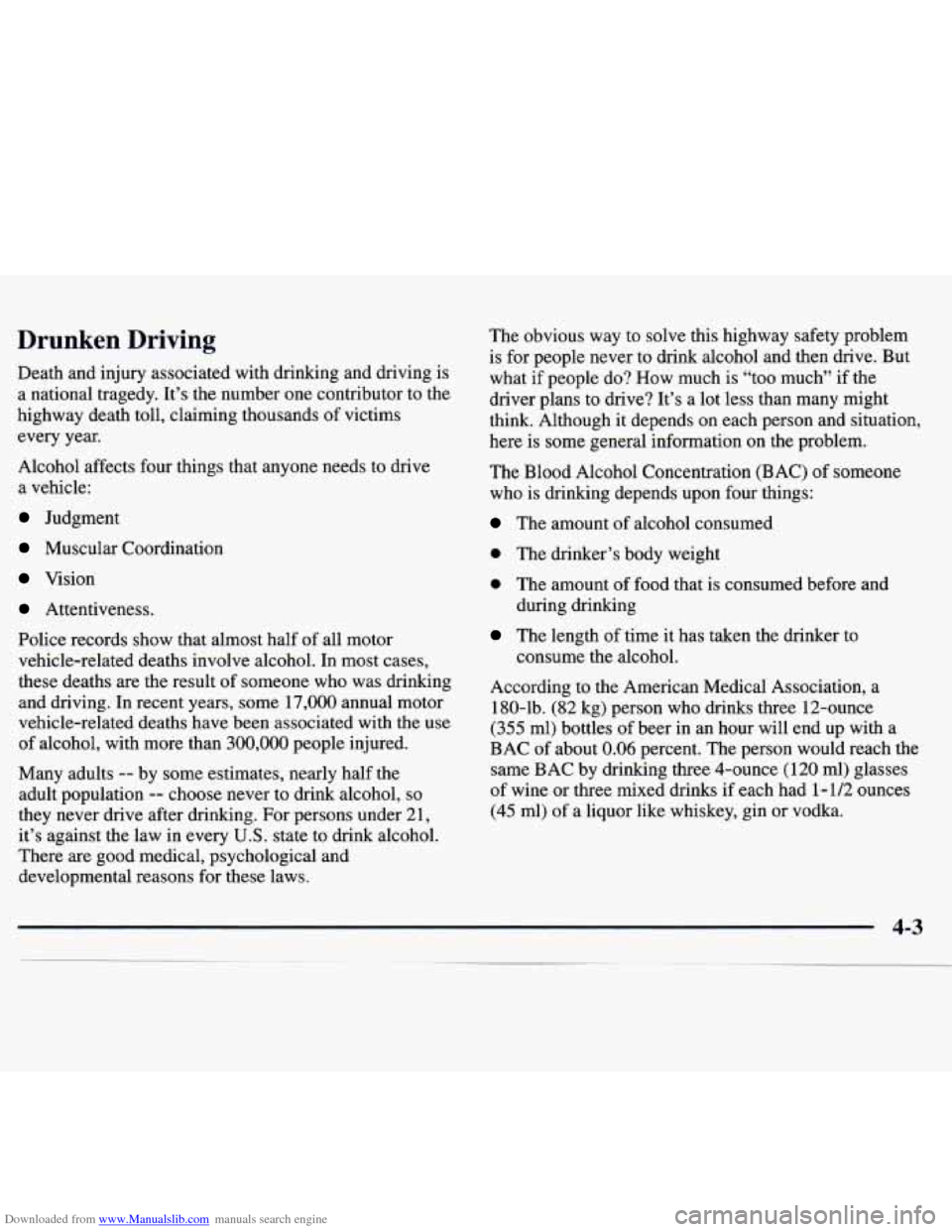1997 CHEVROLET MONTE CARLO length
[x] Cancel search: lengthPage 142 of 358

Downloaded from www.Manualslib.com manuals search engine Drunken Driving
Death and injury associated with drinking and driving is
a national tragedy. It’s the number one contributor to the
highway death toll, claiming thousands
of victims
every year.
Alcohol affects four things that anyone needs to drive
a vehicle:
Judgment
Muscular Coordination
Vision
Attentiveness.
Police records show that almost half
of all motor
vehicle-related deaths involve alcohol. In most cases,
these deaths are the result of someone who was drinking
and driving. In recent years, some 17,000 annual motor
vehicle-related deaths have been associated with the use
of alcohol, with more than
300,000 people injured.
Many adults
-- by some estimates, nearly half the
adult population
-- choose never to drink alcohol, so
they never drive after drinking. For persons under 21,
it’s against the law in every U.S. state to drink alcohol.
There are good medical, psychological and
developmental reasons for these laws. The obvious
way to solve this highway safety problem
is for people never to drink alcohol and then drive. But
what if people do? How much is “too much” if the
driver plans to drive? It’s a lot less than many might
think. Although it depends on each person and situation,
here is some general information on the problem.
The Blood Alcohol Concentration (BAC) of someone
who is drinking depends upon four things:
The amount of alcohol consumed
0 The drinker’s body weight
0 The amount of food that is consumed before and
during drinking
consume the alcohol.
The length of time it has taken the drinker to
According to
the American Medical Association, a
180-lb. (82 kg) person who drinks three 12-ounce
(355 ml) bottles of beer in an hour will end up with a
BAC of about
0.06 percent. The person would reach the
same BAC by drinking three 4-ounce
(1 20 ml) glasses
of wine or three mixed drinks if each had
1- 1/2 ounces
(45 ml) of a liquor like whiskey, gin or vodka.
Page 252 of 358

Downloaded from www.Manualslib.com manuals search engine Windshield Wiper Blade Replacement
Replacement blades for your vehicle are 22 inches
(559 mm) in length.
1. Turn the wipers on to the lowest intermittent setting.
2. Turn off the ignition while the wipers are at the
outer positions
of the wiper pattern. The blades are
more accessible for removal/replacement while in
this position.
3. Pull the windshield wiper arm away from
the windshield.
4. While holding the wiper arm away from the glass,
push the release clip from under the blade
connecting point and pull the blade assembly down
towards the glass to remove
it from the wiper arm.
5. Push the new wiper blade securely on the wiper arm
until you hear the release clip “click” into place.
For wiper blade replacement length and type, also see
“Capacities and Specifications”
in the Index.
Tires
Your new Chevrolet comes with high-quality tires made
by a leading tire manufacturer. If you ever have
questions about your tire warranty and where to obtain
service, see your Chevrolet Warranty booklet for details.
A CAU I I
Poorly maintained and improperly used tires
are dangerous.
0 Overloading your tires can cause overheating
as a result of too much friction. You could
have an airout and a serious accident. See
“Loading Your Vehicle” in the Index.
CAUTION: (Continued)
Page 278 of 358

Downloaded from www.Manualslib.com manuals search engine Replacement Bulbs
Exterior Lamps Bulb Number
Back-up ......................... 3 156 or 3057
Center High-Mounted Stop
............... 891T2
Front ParkingiTurn Signal
............... 3357NA
Headlamp, High-Beam
................... 9005
Headlamp, Low-Beam
.................... 9006
Sidemarker, Front
......................... 194
Sidemarker, Rear
......................... 194
Stop/Tail/Turn Signal
..................... 3057
Interior Lamps Bulb Number
Dome ............................. 10230955
*For service information
on these bulbs, contact your
Chevrolet dealer service department.
Capacities and Specifications
Please refer to “Recommended Fluids and Lubricants”
in
the Index for more information.
Automatic Transaxle
Pan Removal and Replacement ..... 7 quarts (6.7 L)
After Complete Overhaul
......... 10 quarts (9.5 L)
When drainingh-eplucing convertel; more fluid muy
be needed.
Cooling System Including Reservoir
3100 (Code M) .............. 11.6 quarts (10.94 L)
3.4L DOHC (Code
X) ........ 12.3 quarts (1 1.65 L)
Refrigerant (R-l34a),
Air Conditioning* ....... 1.88 pounds (0.85 kg)
Engine Crankcase - Oil and Filter Change
3100 (Code M) ................ 4.5 quarts (4.2 L)
3.4L DOHC (Code
X) .......... 5.5 quarts (5.2 L)
Windshield Wiper Blade Replacement
Length .................... 22 inches (559 mm)
Type
.................................. hook
Fuel Tank
3100 (Code M) .............. 16.6 gallons (62.8 L)
3.4L DOHC (Code
X) ........ 16.6 gallons (62.8 L)
*See “Air Conditioning Refrigerants” later in this section.
Note: All capacities are approximate. When adding,
be sure to
Jill to the approximate level, as
recommended in this manual. See “Recommended
Fluids and Lubricants” in the Index.
Page 280 of 358

Downloaded from www.Manualslib.com manuals search engine Normal Maintenance Replacement PC.?-
Air Cleaner Filter
Battery
3100 (Code M) ....................... 600 CCA
3.4L DOHC (Code
X) ................. 690 CCA
Engine Oil Filter
3100(CodeM) .......................... PF47
3.4L DOHC (Code
X) .................... PF51
PCV Valve
3100 (Code M) ....................... CV892C
3.4L DOHC (Code
X) ................. CV895C
Radiator Cap
All Engines ............................. RC27
Spark Plugs
3100 (Code M) ........................ .41-940
Gap: 0.060”
(. 152 cm)
3.4L DOHC (Code
X) .................. .41-919
Gap:
0.045” (. 1 14 cm)
All
Engines
........................... A1208C
Vehicle Dimensions
Wheelbase .............. 107.5 inches (273 .O cm)
Tread Width (Front)
........ 59.5 inches (15 1.2 cm)
Tread Width (Rear)
........ 59.0 inches ( 150.0 cm)
Length
................. 200.7 inches (509.9 cm)
Width
................... 72.5 inches ( 184.2 cm)
Height..
................. 53.8 inches (136.8 cm)
Air Conditioning Refrigerants
Not all air conditioning refrigerants are the same.
If the air conditioning system in your vehicle needs
refrigerant, be sure the proper refrigerant is used.
If you’re not sure, ask your Chevrolet dealer.